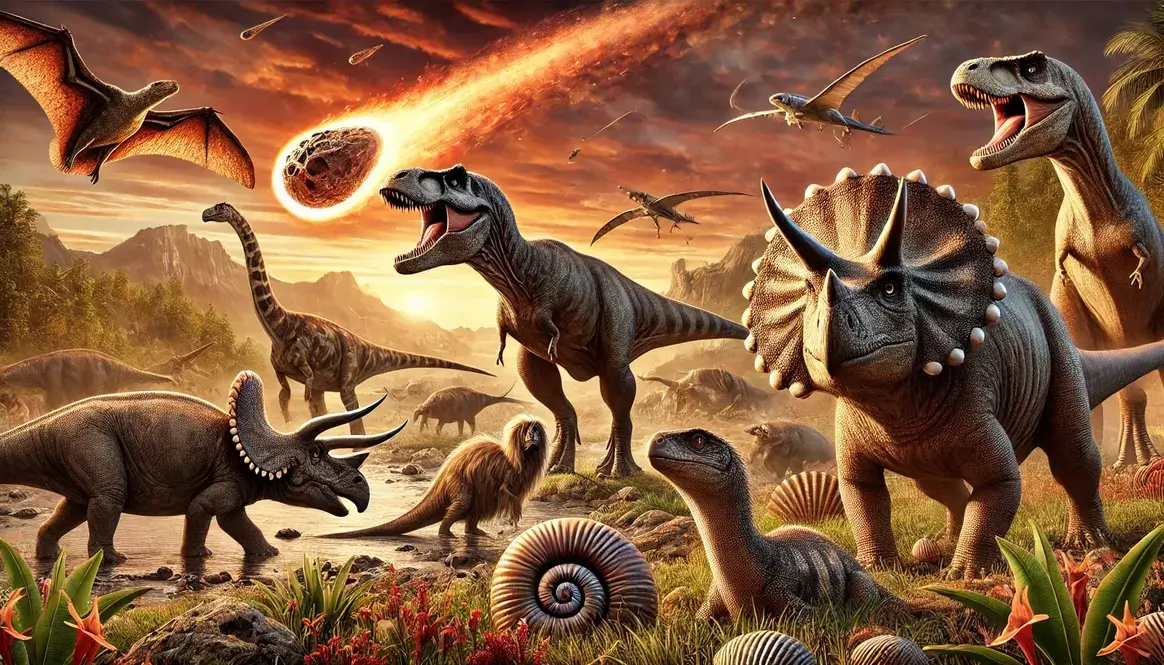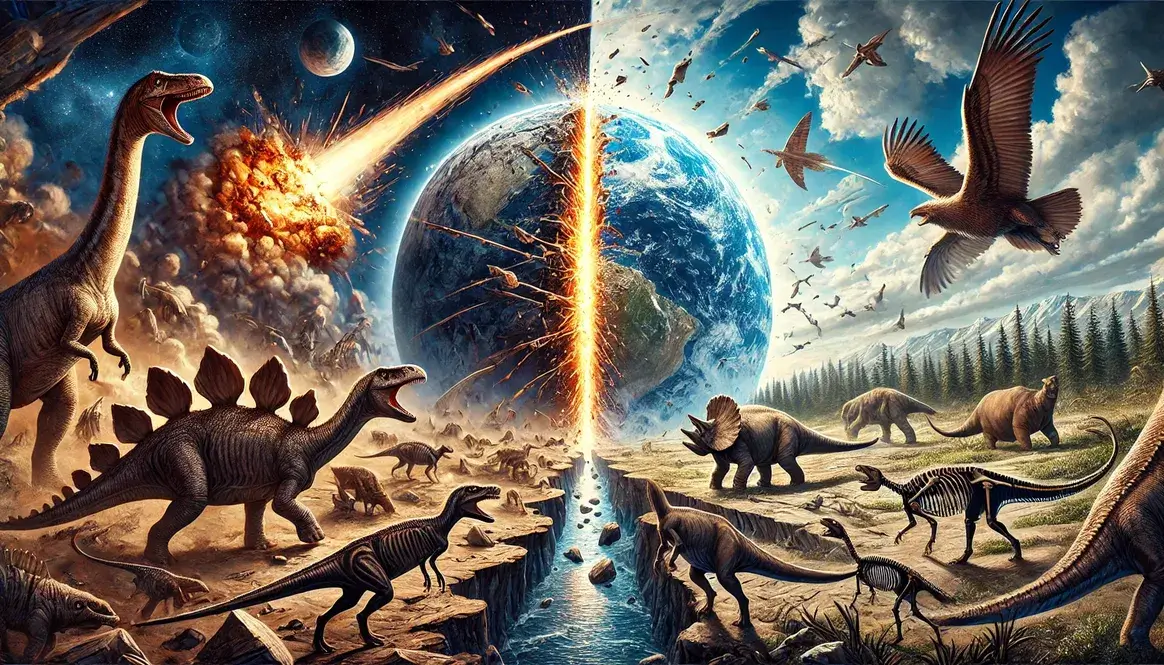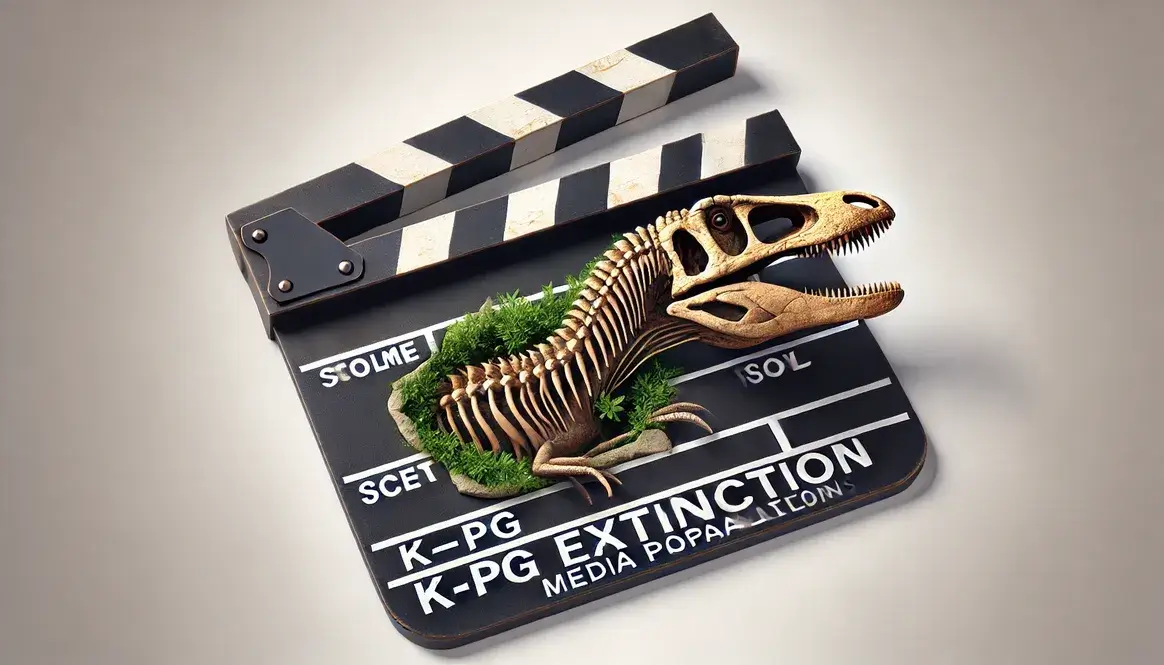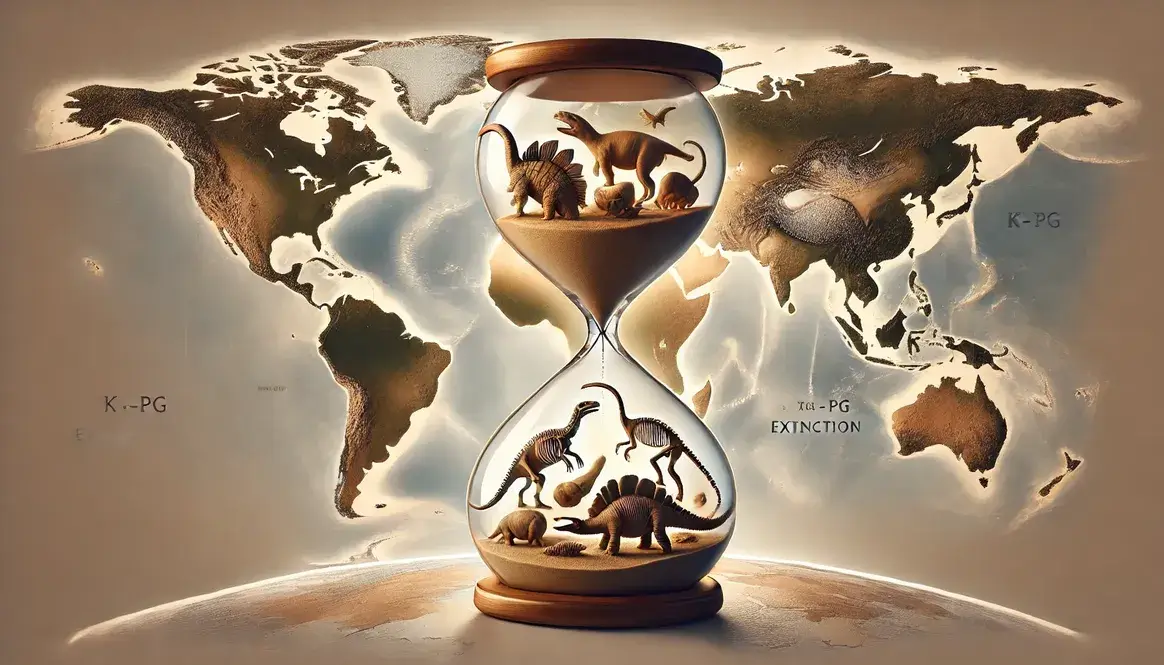About 66 million years ago, Earth experienced a catastrophic event that changed life on our planet forever. This event, known as the K-Pg extinction (short for Cretaceous-Paleogene extinction), wiped out a huge number of animal species. The main cause? A massive asteroid that slammed into what’s now the Yucatan Peninsula in Mexico.
This cosmic collision kicked up so much dust and debris that it blocked out the sun for months or even years. The resulting climate change and food shortages led to a domino effect of extinctions across the globe. Understanding which animals died during this event helps us grasp the enormous impact it had on Earth’s ecosystems and the course of evolution.
Animals that died in K-Pg extinction: Major groups
The K-Pg extinction didn’t affect all animals equally. Some groups were hit harder than others. Let’s take a look at the main categories of animals that suffered during this event.
Non-avian dinosaurs
The most famous victims of the K-Pg extinction were the non-avian dinosaurs. These were all dinosaurs except for the bird-like ones that eventually evolved into modern birds. Why did most dinosaurs go extinct? Their large size and specific diets made it tough for them to adapt to the rapidly changing environment after the asteroid hit.
Some notable extinct dinosaur species include:
- Tyrannosaurus rex: This top predator couldn’t find enough food to sustain its massive body.
- Triceratops: These plant-eaters lost their food sources when vegetation died off.
- Velociraptor: Despite their intelligence, these small predators couldn’t survive the changing world.
Marine reptiles
The oceans weren’t safe from the K-Pg extinction either. Many groups of marine reptiles that had ruled the seas for millions of years met their end. These included:
- Mosasaurs: Large, predatory marine lizards that dominated the oceans.
- Plesiosaurs: Long-necked marine reptiles, including the famous Elasmosaurus.
- Ichthyosaurs: Dolphin-like reptiles that had already started declining before the extinction.
These marine reptiles likely died out due to the collapse of marine food chains and changes in ocean chemistry caused by the asteroid impact.
Flying reptiles
The skies weren’t spared from the K-Pg extinction either. Pterosaurs, the flying reptiles that had dominated the air for over 150 million years, met their end during this event. These incredible creatures, with wingspans ranging from tiny to enormous, couldn’t adapt to the rapidly changing environment.
Some notable extinct pterosaur species include:
- Quetzalcoatlus: One of the largest known flying creatures ever, with a wingspan of up to 10-11 meters.
- Pteranodon: A well-known pterosaur with a distinctive crest on its head.
- Nyctosaurus: A unique pterosaur with an unusually large, antler-like crest.
The extinction of pterosaurs left the skies open for birds to diversify and evolve into the many species we see today.
Large marine animals
The K-Pg extinction hit marine ecosystems hard, affecting more than just reptiles. Many large marine creatures that had thrived for millions of years vanished during this event.
Ammonites, those iconic spiral-shelled relatives of modern squid and octopuses, were among the casualties. These creatures had been around for over 300 million years but couldn’t survive the changing ocean conditions.
Large filter-feeding fish, like Pachycormids, also went extinct. These gentle giants, some reaching lengths of up to 9 meters, filtered plankton from the water much like modern whales.
The loss of these animals had a profound impact on ocean ecosystems:
- Food chains were disrupted, causing cascading effects throughout marine environments.
- Nutrient cycling in the oceans changed dramatically.
- New ecological niches opened up, paving the way for the evolution of modern marine mammals.
Discover more about the K-Pg boundary
Terrestrial animals
While dinosaurs often steal the spotlight, many other land-dwelling animals were affected by the K-Pg extinction. The changing climate and loss of vegetation hit various groups hard.
Some terrestrial animals that went extinct include:
- Champsosaurus: A crocodile-like reptile that lived in freshwater environments.
- Albanerpetontids: Salamander-like amphibians that had survived several previous mass extinctions.
- Multituberculates: An ancient group of mammals that looked a bit like rodents.
It’s important to note that not all terrestrial animals died out. Some groups, like certain small mammals, managed to survive and went on to evolve into the diverse array of land animals we see today.
Percentage of species lost in the K-Pg extinction
The K-Pg extinction was one of the most severe mass extinctions in Earth’s history. The overall extinction rate was staggering, with a significant percentage of species disappearing in a geologically short time.
Let’s break down the extinction rates across different animal groups:
| Animal Group | Estimated Extinction Rate |
|---|---|
| Non-avian Dinosaurs | 100% |
| Marine Reptiles | 100% |
| Pterosaurs | 100% |
| Ammonites | 100% |
| Marine Plankton | 70-90% |
| Land Plants | 50-75% |
| Mammals | 50-75% |
These numbers are truly mind-boggling when compared to background extinction rates. Normally, species go extinct at a rate of about 1-5 species per year. During the K-Pg extinction, this rate skyrocketed to thousands of species in a relatively short time span.
Patterns of extinction across different habitats
The K-Pg extinction didn’t affect all environments equally. The patterns of extinction varied significantly depending on the habitat, with some ecosystems hit harder than others.
Marine ecosystems
Marine environments suffered some of the highest extinction rates during the K-Pg event. The oceans saw a staggering loss of biodiversity, with some estimates suggesting that up to 75% of marine species went extinct.
Several factors contributed to the high extinction rates in marine ecosystems:
- Acid rain: The impact released sulfur into the atmosphere, leading to acid rain that changed ocean chemistry.
- Darkness: The dust cloud blocked sunlight, disrupting photosynthesis in marine plants and algae.
- Temperature changes: Rapid cooling followed by warming affected many temperature-sensitive marine species.
- Food chain collapse: The loss of phytoplankton at the base of the food chain had cascading effects on larger marine animals.
The extinction patterns in marine ecosystems weren’t uniform. Shallow water species were generally hit harder than those in deeper waters. This is likely because shallow water environments experienced more dramatic changes in temperature and chemistry.
Interestingly, some marine ecosystems showed signs of recovery relatively quickly after the extinction event, while others took millions of years to bounce back. This varied recovery rate gives us insights into the resilience of different marine habitats and the complexity of ecosystem recovery after a mass extinction.
Terrestrial ecosystems
The K-Pg extinction had a profound impact on land-dwelling creatures, with extinction rates varying across different groups. While not as severe as in marine environments, terrestrial ecosystems still experienced significant losses.
Extinction rates on land:
- Plants: Approximately 50-75% of species went extinct
- Insects: Around 50% of species disappeared
- Terrestrial vertebrates: Up to 75% of species vanished
Several factors contributed to these terrestrial extinctions:
- Global cooling: The dust cloud from the impact blocked sunlight, causing temperatures to plummet.
- Lack of food: Plant die-offs led to a collapse of food chains.
- Wildfires: Widespread fires destroyed habitats and killed many animals directly.
- Acid rain: Chemical changes in the atmosphere led to acid rain, damaging plants and freshwater ecosystems.
The changes in land environments were drastic and long-lasting. However, the survival of some small, adaptable species allowed for the eventual recovery and diversification of terrestrial life.
Freshwater ecosystems
Freshwater environments, including rivers, lakes, and wetlands, faced their own unique challenges during the K-Pg extinction. While often overlooked, these ecosystems played a crucial role in the survival and recovery of life on Earth.
Impact on freshwater species:
- Extinction rates varied widely depending on the type of habitat
- Some groups, like certain amphibians and freshwater fish, were less affected than their marine counterparts
- Other groups, such as aquatic reptiles like champsosaurs, went completely extinct
Interestingly, freshwater ecosystems generally fared better than both marine and terrestrial environments during the K-Pg extinction. This resilience can be attributed to several factors:
- Buffering effect of surrounding land
- More stable temperatures in deep lakes
- Ability of many freshwater species to enter dormant states
Here’s a comparison of estimated extinction rates across different ecosystems:
| Ecosystem Type | Estimated Extinction Rate |
|---|---|
| Marine | 70-90% |
| Terrestrial | 50-75% |
| Freshwater | 30-50% |
This lower extinction rate in freshwater ecosystems may have played a crucial role in the recovery of life after the K-Pg event. Many surviving species found refuge in these environments, eventually repopulating other habitats as conditions improved.
The varied impact of the K-Pg extinction across different ecosystems highlights the complexity of mass extinction events. Understanding these patterns can provide valuable insights into how life responds to global catastrophes and the importance of diverse habitats in preserving biodiversity.
Notable extinct species from the K-Pg extinction
The K-Pg extinction event wiped out countless species, but some stand out due to their iconic status or unique characteristics. These extinct creatures capture our imagination and help us understand the magnitude of the loss during this cataclysmic period. Let’s explore some of the most famous animals that died in the K-Pg extinction.
Tyrannosaurus rex
Tyrannosaurus rex, the “tyrant lizard king,” was one of the most fearsome predators to ever walk the Earth. This massive theropod dinosaur lived during the late Cretaceous period and met its end during the K-Pg extinction.
Key T. rex facts:
- Length: Up to 40 feet (12 meters)
- Weight: 5-7 tons
- Diet: Carnivorous
- Known for: Powerful jaws and tiny arms
T. rex couldn’t survive the extinction for several reasons:
- Size: Its large body required vast amounts of food, which became scarce after the asteroid impact.
- Specialization: As a top predator, T. rex was dependent on a stable ecosystem.
- Limited adaptability: The rapid environmental changes outpaced T. rex’s ability to evolve.
The extinction of T. rex and other large predators altered food chains dramatically, paving the way for new species to evolve and fill these ecological niches.
Triceratops
Triceratops, with its distinctive three-horned face and large bony frill, was one of the last non-avian dinosaurs to exist before the K-Pg extinction. This herbivorous dinosaur was a common sight in late Cretaceous North America.
Triceratops was a remarkable animal:
- Length: Up to 30 feet (9 meters)
- Weight: 4-6 tons
- Notable features: Three facial horns and a large neck frill
- Diet: Herbivorous, specializing in tough, fibrous plants
Several factors contributed to Triceratops’ extinction:
- Plant dependence: The loss of vegetation following the asteroid impact left Triceratops without a food source.
- Size: Like T. rex, Triceratops’ large body required significant amounts of food to sustain it.
- Habitat destruction: Widespread fires and environmental changes destroyed the ecosystems Triceratops relied on.
- Slow reproduction: Large dinosaurs like Triceratops had long gestation periods and took years to reach maturity, making it difficult for the population to recover from sudden losses.
The extinction of Triceratops and other large herbivores had a ripple effect throughout the ecosystem, affecting both the plants they fed on and the predators that hunted them. This demonstrates how the loss of even one species can have far-reaching consequences in a complex ecological web.
Mosasaurs
Mosasaurs were the apex predators of the late Cretaceous seas, ruling the oceans for over 30 million years before their sudden demise. These massive marine reptiles were distant relatives of modern-day snakes and lizards, but adapted for a life of aquatic domination.
Key characteristics of mosasaurs:
- Length: Some species reached up to 50 feet (15 meters)
- Powerful, streamlined bodies
- Double-hinged jaws for swallowing large prey
- Flippers and a shark-like tail for swift swimming
Mosasaurs went extinct during the K-Pg event due to several factors:
- Disruption of marine food chains
- Changes in ocean chemistry and temperature
- Competition with other marine predators
- Inability to adapt quickly to rapid environmental changes
The extinction of mosasaurs left a significant gap in marine ecosystems, eventually filled by evolving mammals like whales and dolphins.
Pteranodon
Pteranodon was one of the most recognizable flying reptiles of the late Cretaceous period. These remarkable creatures soared above the ancient seas, using their massive wingspans to glide effortlessly on air currents.
Pteranodon quick facts:
- Wingspan: Up to 23 feet (7 meters)
- Diet: Primarily fish
- Notable feature: Long, toothless beak
- Habitat: Coastal regions
Pterosaurs like Pteranodon were particularly vulnerable to the K-Pg extinction for several reasons:
- Specialized diets: Many pterosaurs relied on specific food sources that disappeared during the extinction event.
- Fragile bones: Their lightweight, hollow bones, while perfect for flight, made them more susceptible to injury and death during catastrophic events.
- Low reproductive rates: Like many large reptiles, pterosaurs likely produced few offspring, making population recovery difficult.
- Competition: As flying creatures evolved, early birds may have outcompeted pterosaurs for limited resources.
The extinction of pterosaurs opened up aerial niches, allowing birds to diversify and eventually dominate the skies.
Lessons from the K-Pg extinction
The K-Pg extinction event provides valuable insights into the nature of biodiversity and ecosystem resilience. By studying this ancient catastrophe, we can draw important lessons for modern conservation efforts.
- Biodiversity is crucial for ecosystem resilience
- Diverse ecosystems are more likely to survive major disturbances
- The loss of key species can have cascading effects throughout food webs
- Rapid environmental changes pose significant challenges
- Species need time to adapt to new conditions
- Even successful groups can go extinct if changes occur too quickly
- Size and specialization can be vulnerabilities
- Larger animals and dietary specialists are often at greater risk during extinction events
- Generalists and smaller species tend to be more resilient
- Recovery takes time
- Ecosystems can take millions of years to fully recover from mass extinctions
- The trajectory of recovery can lead to entirely new ecological communities
These lessons have important implications for modern conservation efforts:
- Protecting biodiversity should be a priority, as it increases ecosystem resilience
- Conservation strategies should consider the interconnectedness of species within ecosystems
- Efforts to mitigate rapid environmental changes, such as climate change, are crucial for species survival
- Special attention should be given to protecting large and specialized species, as they may be particularly vulnerable
By understanding the patterns and consequences of past extinction events like the K-Pg extinction, we can better prepare for and potentially mitigate future ecological crises. The animals that died in the K-Pg extinction serve as a stark reminder of the fragility of life and the importance of maintaining Earth’s biodiversity.









